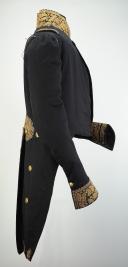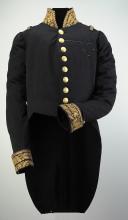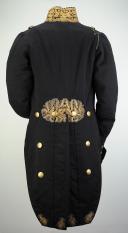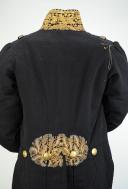
Dress coat of Lieutenant General (Divisional General) Jean Maximilien Lamarque, July Monarchy.
Sold out
FULL-DRESS COAT OF LIEUTENANT GENERAL (DIVISION GENERAL) JEAN MAXIMILIEN LAMARQUE, JULY MONARCHY.
Coat made of dark blue satin almost black, closed on the chest with a row of nine large 1830 uniform buttons (half-rounded, gold in a matte and burnished finish, embossed and relief on a background of a bundle of flags of the Gallic rooster) with a diameter of 25 mm.
Collar in dark blue satin, 75 mm high, embroidered with threads, cannetilles, and golden sequins in two rows of oak leaves approximately 40 mm wide for the upper branch and 25 mm for the lower one, bordered at the top with a scalloped strip; it is rounded at the front.
Sleeves end with a straight cuff 88 mm in height, of the same fabric as the tunic, and embroidered with threads, cannetilles, and golden sequins in two rows of oak leaves (the upper row is about 37 mm wide and the second about 27 mm), bordered at the top with a scalloped strip.
Shoulder loops in passementerie of threads, cannetilles, and golden sequins (length 90 mm, width 14 mm).
At the bottom of the back, a series of oak and laurel branches are embroidered with two uniform buttons.
False pockets at the height filled with three uniform buttons each.
At the bottom of each basque fold, a gold embroidered badge on blue fabric is sewn, representing a winged lightning bolt of the staff topped with the imperial crown with an anchor above, embroidery height 65 mm width 50 mm.
Perfect condition.
France.
July Monarchy.
PROVENANCE:
Coat from the auction of General Lamarque's memorabilia on April 10, 1992, master DUVAL auctioneer in Bordeaux.
BIOGRAPHY:
Jean Maximilien Lamarque, born in Saint-Sever (Landes) on July 22, 1770, died of cholera on June 1, 1832, was a French general officer who had a career in the armies of the Revolution and the Empire, particularly in the Vendée and Spain wars.
Childhood and Education:
Jean Maximilien Lamarque grew up in a very wealthy family. His father Pierre-Joseph Lamarque (1733-1802) was a lawyer at the parliament, prosecutor for the king at the seneschal of Saint-Sever.
He was sent to the college of the Jacobins in Saint-Sever, where one of his uncles, Jean-Jacques Lamarque (1737-1809), was prior, before becoming the director of the grand seminary of Dax, then vicar general of the diocese. In 1791, this uncle refused to swear allegiance and was persecuted during the Terror.
Jean Maximilien excelled in his studies there.
French Revolution:
His father Pierre-Joseph Lamarque (1733-1802), elected deputy of the Third Estate to the Estates General of 1789, took the Tennis Court Oath and was part of the Constituent National Assembly.
In March 1790, the young Jean Maximilien, aged 19, left his hometown to join his father in Paris to further his studies, attending courses from notable figures like Chaptal, La Harpe, and Chamfort. He fervently mingled in the city's political life and enlisted as a simple soldier in 1792. Shortly after, he led the battalion that pillaged the cathedral of Vabres, removing the marbles from the altar to build a monument and honor Marat's memory. He then set the building on fire.
In early 1793, he was in the 4th battalion of volunteers from the Landes region.
Military Life and Career:
Wars of the French Revolution:
Appointed lieutenant on April 3, 1793, he became a captain of grenadiers on May 13, 1793, in the famous infernal column of the Tour d'Auvergne in the army of the Western Pyrenees.
His Military Life and Ascension:
Wars of the French Revolution:
Appointed lieutenant on April 3, 1793, he became a captain of grenadiers on May 13, 1793, in the famous infernal column of the Tour d'Auvergne in the army of the Western Pyrenees. He distinguished himself particularly by capturing the city of Fontarabie on July 24, 1794, with a reduced force, despite it being defended by 1700 men.
On the 21st Thermidor year II, he was promoted to battalion chief and served in the army of the Rhine. He notably participated in the battles of Engen (May 3, 1800), Messkirch (June 5, 1800), Höchstädt (June 19, 1800), and finally Hohenlinden (December 3, 1800), where he gained glory, leading to a request from General Moreau to receive the epaulettes of a brigadier general on March 6, 1801, from Bonaparte's hands.
Wars of the Empire:
He subsequently participated in the campaigns of the Imperial army, excelling notably at Austerlitz where he commanded a brigade of Marshal Augereau's 7th corps. He then left the Grande Armée to follow, with Marshal Masséna, Joseph Bonaparte to Italy, taking part in the siege of Gaeta. On December 6, 1807, having established himself on the throne of Naples, Joseph appointed Jean Maximilien Lamarque as his chief of staff, with the rank of division general.
When Marshal Murat, Grand Duke of Berg and Cleves, succeeded his brother-in-law in the Kingdom of Naples, Jean Maximilien Lamarque took on the task on December 18, 1808, of capturing the island of Capri. The English garrison under the command of Hudson Lowe, the future jailer of the Emperor on Saint Helena, defied French presence, with the British flag visible from the windows of the royal palace. This action was seen as one of the most remarkable feats of the Napoleonic wars, requiring courage, audacity, and intelligence. Due to the natural terrain of the island, which seemed impregnable, surrounded by sheer cliffs topped with heavily armed enemy defenses, one could only approach it by climbing under the intense fire of a numerous garrison. Lamarque led the assault at the head of his men, removed the ladders, and withdrew the ships to eliminate any possibility of retreat; the French troops were left with only the options of being decimated on the spot or vanquishing, which they managed to do after multiple attempts to breach the English defenses, imposing a capitulation on the enemy, giving the French control over storages, ammunition, and workshops. Acknowledging the valor of his opponents, General Lamarque granted freedom to the English to leave the island without arms or belongings.
General Lamarque left the Kingdom of Naples in 1809 to join, with his division, the army of Prince Eugène de Beauharnais in Northern Italy. He seized Leybach where he captured 4000 prisoners and 65 pieces of artillery, then joined the Grande Armée at Lobau, and notably contributed to the battle of Wagram where, in the heat of battle, he had four horses killed beneath him.
He was appointed Empire Baron by letters patent issued on June 4, 1810.
Later, with the Spanish affair mobilizing French forces, Jean Maximilien Lamarque found himself alongside King Joseph and, on February 8, 1812, achieved victory with his division at the battle of Altafulla.
Restoration and Hundred Days:
During the first Restoration, General Lamarque reluctantly rallied to the Bourbons, but, captivated by the Emperor's persona, he followed him during the Hundred Days, tasked with pacifying the Vendée region which had risen up again upon hearing of Napoleon's return from Elba. General Lamarque succeeded in his mission, disarmed the insurgents, to the point where their leaders, after the signing of the peace in Cholet, offered to “serve under his command, as Frenchmen, to prevent any attempts by foreign powers to dismember France.”
General Lamarque's military career came to an end with the fall of the Empire. Banished during the Second Restoration, he only returned to France following the royal ordinance of October 20, 1818. Kept in availability, he was retired by Charles X on June 30, 1830. As recognition of his past services and perhaps also due to his opposition to the Restoration regime, Louis-Philippe, the new king of the French, elevated him on August 21, 1830, to the rank of Grand Cross of the Legion of Honor.
His Political Life: From Bonapartist to Liberal:
Jean Maximilien Lamarque was also a writer and a deputy, a liberal opponent of the Restoration government.
During his exile in Belgium and then in Holland, he pursued literature by translating into verse the poems of Ossian by James Macpherson, which his family later published. In the preface, he portrayed the customs of the Caledonians and studied their literature. His translation of these five Ossianic chants shows great culture and enlightened romanticism. Drawing comparisons with Virgil, Tasso, Milton, and even Voltaire, Lamarque also made links to Homer, whom he knew perfectly well.
Upon returning to France during Louis-Philippe I's reign, General Lamarque became passionate about agriculture, leveraging the wealth he had accumulated during the Revolution to purchase farms, mills, and various lands. He aimed, as he himself stated, to aid in “humanizing” the arid soil of the Landes region through his agronomic work. A keen follower of physiocrats, he studied ways to improve the condition of rural residents by advocating soil amendments, the crop rotation system, and giving maize a prominent place. Invited to join the Agricultural Society of the Landes, he was admitted on July 8, 1827, and described in his induction speech his efforts and attempts in agronomy. Additionally, despite criticizing the industrial bourgeoisie of his era, whom he believed, rightly or wrongly, to disdain anything that did not generate immediate wealth, Jean Maximilien Lamarque broadened his horizons. In 1825, he published a paper on “The Advantages of a Navigation Canal Parallel to the Adour,” aiming to open up the Pyrenean Piedmont and territories forming the high Garonne valley and the Adour basin to foreign trade through the port of Bayonne. While this was only a speculative intellectual venture without practical follow-up, it raised the issue of opening these regions to an open economy with the outside world and even abroad.
Amid these economic considerations, it's possible this paper, recalling the challenges posed by the Spanish War in which Lamarque had actively participated for years, was not entirely devoid of military and strategic implications.
Without any military command since 1815 and retired in Saint-Sever, Jean Maximilien Lamarque turned his attention to politics, finding in this activity an outlet for his forced inaction. A systematic opponent since his return from exile to the senior branch of the Bourbons, whom he reproached for what he saw as a degrading pacifism, and out of loyalty to the Empire, whose restoration he believed was still plausible through the King of Rome, he ran for office in 1820 but initially faced defeat both in the electoral college of Saint-Sever and Mont-de-Marsan. It wasn't until July 1828, following the death of Marquis Du Lyon, former mayor of Mont-de-Marsan, that partial elections allowed him to win as a deputy on December 23, 1828, against Baron de Poyferré de Cère. He was reelected by the Mont-de-Marsan electoral college on June 23, 1830, defeating Baron d'Haussez, after Minister Polignac dissolved the Chamber on May 16.
Names engraved under the Arc de Triomphe: West pillar, 35th and 36th columns.
He rallied to the July Monarchy hoping to establish a genuine liberal regime, although he continued to lament what he perceived as an incongruent pacifism with France's greatness. Although he continued to sit on the left side of the Chamber, he remained a centrist, believing that true liberals were targets for both ultras nostalgic for the Ancien Régime and extremists seeking to relive the 1793 era.
End of His Life:
Lamarque died of cholera on June 1, 1832. His funeral became a pretext for the republican insurgency of 1832 (servant as a backdrop to parts of Victor Hugo's "Les Misérables"), which was suppressed by the troops. Lamarque had become a popular symbol, admired for his reputation as a former officer and principled politician from the Revolution and Napoleonic era, as well as for his republican commitment. He was respected for his active leadership. He was a popular left-wing deputy and one of the republican leaders. Consequently, the republican supporters were displeased when the last honors for this staunch republican were paid by legitimist royalists; they viewed it as a form of co-optation. The scale of the insurgency was such that Louis-Philippe reportedly considered leaving Paris. A curious epilogue for a life filled with contrasts, which ultimately ended where it began, in the family chapel of Eyres-Moncube, erected in the Chalosse land that was his own.
Napoleon's Opinion:
"The generals who seemed destined for greatness were Gérard, Clausel, Foy, Lamarque, etc. They were my new marshals."
"During the last insurrections in the Vendée, General Lamarque, whom I had sent there at the height of the crisis, performed wonders and surpassed my expectations."
"Was it, on Lamarque's part, ignorance of the true state of affairs, or just the fantasy of the victor? In any case, here he is in exile: he is among the thirty-eight. It is easier to proscribe than to conquer." (Napoleon at Saint Helena).
NOTE:
The title of lieutenant-general was once again used in place of "division general" and maréchal de camp used instead of "brigadier general" during the Restoration and July Monarchy, disappearing definitively in 1848.
Coat made of dark blue satin almost black, closed on the chest with a row of nine large 1830 uniform buttons (half-rounded, gold in a matte and burnished finish, embossed and relief on a background of a bundle of flags of the Gallic rooster) with a diameter of 25 mm.
Collar in dark blue satin, 75 mm high, embroidered with threads, cannetilles, and golden sequins in two rows of oak leaves approximately 40 mm wide for the upper branch and 25 mm for the lower one, bordered at the top with a scalloped strip; it is rounded at the front.
Sleeves end with a straight cuff 88 mm in height, of the same fabric as the tunic, and embroidered with threads, cannetilles, and golden sequins in two rows of oak leaves (the upper row is about 37 mm wide and the second about 27 mm), bordered at the top with a scalloped strip.
Shoulder loops in passementerie of threads, cannetilles, and golden sequins (length 90 mm, width 14 mm).
At the bottom of the back, a series of oak and laurel branches are embroidered with two uniform buttons.
False pockets at the height filled with three uniform buttons each.
At the bottom of each basque fold, a gold embroidered badge on blue fabric is sewn, representing a winged lightning bolt of the staff topped with the imperial crown with an anchor above, embroidery height 65 mm width 50 mm.
Perfect condition.
France.
July Monarchy.
PROVENANCE:
Coat from the auction of General Lamarque's memorabilia on April 10, 1992, master DUVAL auctioneer in Bordeaux.
BIOGRAPHY:
Jean Maximilien Lamarque, born in Saint-Sever (Landes) on July 22, 1770, died of cholera on June 1, 1832, was a French general officer who had a career in the armies of the Revolution and the Empire, particularly in the Vendée and Spain wars.
Childhood and Education:
Jean Maximilien Lamarque grew up in a very wealthy family. His father Pierre-Joseph Lamarque (1733-1802) was a lawyer at the parliament, prosecutor for the king at the seneschal of Saint-Sever.
He was sent to the college of the Jacobins in Saint-Sever, where one of his uncles, Jean-Jacques Lamarque (1737-1809), was prior, before becoming the director of the grand seminary of Dax, then vicar general of the diocese. In 1791, this uncle refused to swear allegiance and was persecuted during the Terror.
Jean Maximilien excelled in his studies there.
French Revolution:
His father Pierre-Joseph Lamarque (1733-1802), elected deputy of the Third Estate to the Estates General of 1789, took the Tennis Court Oath and was part of the Constituent National Assembly.
In March 1790, the young Jean Maximilien, aged 19, left his hometown to join his father in Paris to further his studies, attending courses from notable figures like Chaptal, La Harpe, and Chamfort. He fervently mingled in the city's political life and enlisted as a simple soldier in 1792. Shortly after, he led the battalion that pillaged the cathedral of Vabres, removing the marbles from the altar to build a monument and honor Marat's memory. He then set the building on fire.
In early 1793, he was in the 4th battalion of volunteers from the Landes region.
Military Life and Career:
Wars of the French Revolution:
Appointed lieutenant on April 3, 1793, he became a captain of grenadiers on May 13, 1793, in the famous infernal column of the Tour d'Auvergne in the army of the Western Pyrenees.
His Military Life and Ascension:
Wars of the French Revolution:
Appointed lieutenant on April 3, 1793, he became a captain of grenadiers on May 13, 1793, in the famous infernal column of the Tour d'Auvergne in the army of the Western Pyrenees. He distinguished himself particularly by capturing the city of Fontarabie on July 24, 1794, with a reduced force, despite it being defended by 1700 men.
On the 21st Thermidor year II, he was promoted to battalion chief and served in the army of the Rhine. He notably participated in the battles of Engen (May 3, 1800), Messkirch (June 5, 1800), Höchstädt (June 19, 1800), and finally Hohenlinden (December 3, 1800), where he gained glory, leading to a request from General Moreau to receive the epaulettes of a brigadier general on March 6, 1801, from Bonaparte's hands.
Wars of the Empire:
He subsequently participated in the campaigns of the Imperial army, excelling notably at Austerlitz where he commanded a brigade of Marshal Augereau's 7th corps. He then left the Grande Armée to follow, with Marshal Masséna, Joseph Bonaparte to Italy, taking part in the siege of Gaeta. On December 6, 1807, having established himself on the throne of Naples, Joseph appointed Jean Maximilien Lamarque as his chief of staff, with the rank of division general.
When Marshal Murat, Grand Duke of Berg and Cleves, succeeded his brother-in-law in the Kingdom of Naples, Jean Maximilien Lamarque took on the task on December 18, 1808, of capturing the island of Capri. The English garrison under the command of Hudson Lowe, the future jailer of the Emperor on Saint Helena, defied French presence, with the British flag visible from the windows of the royal palace. This action was seen as one of the most remarkable feats of the Napoleonic wars, requiring courage, audacity, and intelligence. Due to the natural terrain of the island, which seemed impregnable, surrounded by sheer cliffs topped with heavily armed enemy defenses, one could only approach it by climbing under the intense fire of a numerous garrison. Lamarque led the assault at the head of his men, removed the ladders, and withdrew the ships to eliminate any possibility of retreat; the French troops were left with only the options of being decimated on the spot or vanquishing, which they managed to do after multiple attempts to breach the English defenses, imposing a capitulation on the enemy, giving the French control over storages, ammunition, and workshops. Acknowledging the valor of his opponents, General Lamarque granted freedom to the English to leave the island without arms or belongings.
General Lamarque left the Kingdom of Naples in 1809 to join, with his division, the army of Prince Eugène de Beauharnais in Northern Italy. He seized Leybach where he captured 4000 prisoners and 65 pieces of artillery, then joined the Grande Armée at Lobau, and notably contributed to the battle of Wagram where, in the heat of battle, he had four horses killed beneath him.
He was appointed Empire Baron by letters patent issued on June 4, 1810.
Later, with the Spanish affair mobilizing French forces, Jean Maximilien Lamarque found himself alongside King Joseph and, on February 8, 1812, achieved victory with his division at the battle of Altafulla.
Restoration and Hundred Days:
During the first Restoration, General Lamarque reluctantly rallied to the Bourbons, but, captivated by the Emperor's persona, he followed him during the Hundred Days, tasked with pacifying the Vendée region which had risen up again upon hearing of Napoleon's return from Elba. General Lamarque succeeded in his mission, disarmed the insurgents, to the point where their leaders, after the signing of the peace in Cholet, offered to “serve under his command, as Frenchmen, to prevent any attempts by foreign powers to dismember France.”
General Lamarque's military career came to an end with the fall of the Empire. Banished during the Second Restoration, he only returned to France following the royal ordinance of October 20, 1818. Kept in availability, he was retired by Charles X on June 30, 1830. As recognition of his past services and perhaps also due to his opposition to the Restoration regime, Louis-Philippe, the new king of the French, elevated him on August 21, 1830, to the rank of Grand Cross of the Legion of Honor.
His Political Life: From Bonapartist to Liberal:
Jean Maximilien Lamarque was also a writer and a deputy, a liberal opponent of the Restoration government.
During his exile in Belgium and then in Holland, he pursued literature by translating into verse the poems of Ossian by James Macpherson, which his family later published. In the preface, he portrayed the customs of the Caledonians and studied their literature. His translation of these five Ossianic chants shows great culture and enlightened romanticism. Drawing comparisons with Virgil, Tasso, Milton, and even Voltaire, Lamarque also made links to Homer, whom he knew perfectly well.
Upon returning to France during Louis-Philippe I's reign, General Lamarque became passionate about agriculture, leveraging the wealth he had accumulated during the Revolution to purchase farms, mills, and various lands. He aimed, as he himself stated, to aid in “humanizing” the arid soil of the Landes region through his agronomic work. A keen follower of physiocrats, he studied ways to improve the condition of rural residents by advocating soil amendments, the crop rotation system, and giving maize a prominent place. Invited to join the Agricultural Society of the Landes, he was admitted on July 8, 1827, and described in his induction speech his efforts and attempts in agronomy. Additionally, despite criticizing the industrial bourgeoisie of his era, whom he believed, rightly or wrongly, to disdain anything that did not generate immediate wealth, Jean Maximilien Lamarque broadened his horizons. In 1825, he published a paper on “The Advantages of a Navigation Canal Parallel to the Adour,” aiming to open up the Pyrenean Piedmont and territories forming the high Garonne valley and the Adour basin to foreign trade through the port of Bayonne. While this was only a speculative intellectual venture without practical follow-up, it raised the issue of opening these regions to an open economy with the outside world and even abroad.
Amid these economic considerations, it's possible this paper, recalling the challenges posed by the Spanish War in which Lamarque had actively participated for years, was not entirely devoid of military and strategic implications.
Without any military command since 1815 and retired in Saint-Sever, Jean Maximilien Lamarque turned his attention to politics, finding in this activity an outlet for his forced inaction. A systematic opponent since his return from exile to the senior branch of the Bourbons, whom he reproached for what he saw as a degrading pacifism, and out of loyalty to the Empire, whose restoration he believed was still plausible through the King of Rome, he ran for office in 1820 but initially faced defeat both in the electoral college of Saint-Sever and Mont-de-Marsan. It wasn't until July 1828, following the death of Marquis Du Lyon, former mayor of Mont-de-Marsan, that partial elections allowed him to win as a deputy on December 23, 1828, against Baron de Poyferré de Cère. He was reelected by the Mont-de-Marsan electoral college on June 23, 1830, defeating Baron d'Haussez, after Minister Polignac dissolved the Chamber on May 16.
Names engraved under the Arc de Triomphe: West pillar, 35th and 36th columns.
He rallied to the July Monarchy hoping to establish a genuine liberal regime, although he continued to lament what he perceived as an incongruent pacifism with France's greatness. Although he continued to sit on the left side of the Chamber, he remained a centrist, believing that true liberals were targets for both ultras nostalgic for the Ancien Régime and extremists seeking to relive the 1793 era.
End of His Life:
Lamarque died of cholera on June 1, 1832. His funeral became a pretext for the republican insurgency of 1832 (servant as a backdrop to parts of Victor Hugo's "Les Misérables"), which was suppressed by the troops. Lamarque had become a popular symbol, admired for his reputation as a former officer and principled politician from the Revolution and Napoleonic era, as well as for his republican commitment. He was respected for his active leadership. He was a popular left-wing deputy and one of the republican leaders. Consequently, the republican supporters were displeased when the last honors for this staunch republican were paid by legitimist royalists; they viewed it as a form of co-optation. The scale of the insurgency was such that Louis-Philippe reportedly considered leaving Paris. A curious epilogue for a life filled with contrasts, which ultimately ended where it began, in the family chapel of Eyres-Moncube, erected in the Chalosse land that was his own.
Napoleon's Opinion:
"The generals who seemed destined for greatness were Gérard, Clausel, Foy, Lamarque, etc. They were my new marshals."
"During the last insurrections in the Vendée, General Lamarque, whom I had sent there at the height of the crisis, performed wonders and surpassed my expectations."
"Was it, on Lamarque's part, ignorance of the true state of affairs, or just the fantasy of the victor? In any case, here he is in exile: he is among the thirty-eight. It is easier to proscribe than to conquer." (Napoleon at Saint Helena).
NOTE:
The title of lieutenant-general was once again used in place of "division general" and maréchal de camp used instead of "brigadier general" during the Restoration and July Monarchy, disappearing definitively in 1848.
Reference :
076
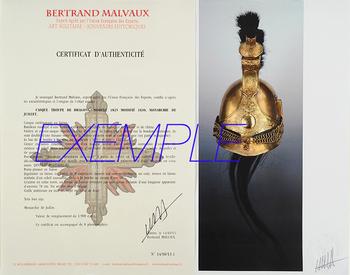
Next update Friday, december 26 at 13:30 PM
FOR ALL PURCHASES, PAYMENT IN MULTIPLE CHECKS POSSIBLE
bertrand.malvaux@wanadoo.fr 06 07 75 74 63
SHIPPING COSTS
Shipping costs are calculated only once per order for one or more items, all shipments are sent via registered mail, as this is the only way to have proof of dispatch and receipt.
For parcels whose value cannot be insured by the Post, shipments are entrusted to DHL or Fedex with real value insured, the service is of high quality but the cost is higher.
RETURN POLICY
Items can be returned within 8 days of receipt. They must be returned by registered mail at the sender's expense, in their original packaging, and in their original condition.
AUTHENTICITY
The selection of items offered on this site allows me to guarantee the authenticity of each piece described here, all items offered are guaranteed to be period and authentic, unless otherwise noted or restricted in the description.
An authenticity certificate of the item including the description published on the site, the period, the sale price, accompanied by one or more color photographs is automatically provided for any item priced over 130 euros. Below this price, each certificate is charged 5 euros.
Only items sold by me are subject to an authenticity certificate, I do not provide any expert reports for items sold by third parties (colleagues or collectors).
FOR ALL PURCHASES, PAYMENT IN MULTIPLE CHECKS POSSIBLE
bertrand.malvaux@wanadoo.fr 06 07 75 74 63
An authenticity certificate of the item including the description published on the site, the period, the sale price, accompanied by one or more color photographs is automatically provided for any item priced over 130 euros. Below this price, each certificate is charged 5 euros.
Only items sold by me are subject to an authenticity certificate, I do not provide any expert reports for items sold by third parties (colleagues or collectors).
